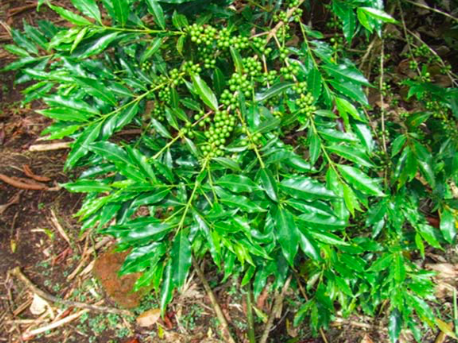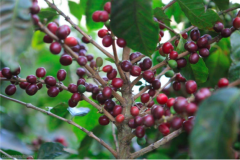Coffee World Map-- Coffee tradition and planting pattern in Ethiopia

For professional baristas, please follow the coffee workshop (Wechat official account cafe_style)
In the Bible. In Genesis, Adam and Eve are expelled from the Garden of Eden for eating the fruit of the Tree of Wisdom. There is no doubt that this fruit has been recognized as an apple (snake) fruit when I read books when I was a child. But in fact, the Bible never mentions its name; the first coffee tree, coincidentally with the earliest human fossil (Ardi), survived about 4.4 million years ago and was found on the same continent. The red coffee fruit has a refreshing effect and seems to be related to wisdom. Therefore, it has been inferred that the Garden of Eden is in Ethiopia.
A quarter of the population participates in coffee production
The spread of coffee shuttles between the northern and southern hemispheres. But in fact, its footprints in its place of origin are also quite tasty. Ethiopia is located in East Africa. Its territory is divided from southwest to north by the African Rift Valley: the mountains in the west are believed to be the source of coffee; the ancient city of Hara in the east is an early Islamic city-state where coffee is exported to Yemen; the southern highlands are world-famous; and Addis Ababa, the current capital, and Lalibela, the ancient capital of the north, in the center of the country, are linked to century-old coffee rituals and traditions. 1/4 people in Ethiopia are directly or indirectly involved in coffee production. Although it is the largest coffee producer in Africa, 40% of it is reserved for domestic sale. Thus it can be seen that coffee is a part of local life.
Kaffa is the cradle of Arabica coffee. Adding up to only a few hundred varieties (congenital or derived) from countries around the world, there are tens of thousands of species in this treasure house, most of which are still unclassified. Heirlooms (original species) is the unique name of Ethiopia, as if to tell the world that its varieties are all-inclusive, with only one word. In addition to the ancient species Typica and Geisha, farmers are also named after their own distinctions, such as the "Sidamo species" and the "Yegashev species". Jimma Agricultural Research Center under the Ministry of Agriculture is cultivated under the code name. For example, Ninety Plus's Kemgin coffee comes from the variety codes 74110 and 7487.
Farmers' planting model is primitive.
Since ancient times, Ethiopians have planted, harvested, treated and cooked by hand. In the 1970s and 1980s of industrialization, the country also benefited from misfortune because it promoted socialism and retained small-scale production under the prohibition of the military regime Derg. Until modern times, the planting mode of farmers is also quite primitive. In the western forest areas (Kaffa, Illubabor), they will use local materials to harvest coffee fruits (Forest Coffees) from wild fruit trees. They don't fertilize or cut tree trunks, so their production capacity is very low. In the Semi Forest Farming model, farmers move trees from the forest to farmland and irrigate them with organic manure. The most common Garden farming is family farming, which is planned by the nursery. More than half of farmers also operate in the most common model in Africa.
After harvest, farmers will sell the fruit to nearby treatment plants. However, because Egypt has registered the production areas (Yirgacheffe, Sidamo, Harar), the law stipulates that farmers in the same area can only be sold to the treatment plants in the same area. The price is also regulated by the government. With the exception of a few accredited cooperatives, all coffee is mixed and auctioned by the Commodity Exchange (ECX). For example, the exchange code WSDB coffee, is the first-class and second-class water wash Sidamo. But this shipment is actually a mixture of Aleda, Wondo, Amaro, Dale, Wensho and other nine producing areas in Sidamo province! Under the tide of boutique products that like to "find the root", the approach of the authorities is going against the trend.
About the customs and anecdotes of coffee in Egypt, the author will talk about it in another article.
Patrick Tam (owner of the boutique coffee shop Knockbox, approved barista of the American Fine Coffee Association and European Fine Coffee Association, CQI recognized cup tester, Cup of Excellence's first Hong Kong judge)
Important Notice :
前街咖啡 FrontStreet Coffee has moved to new addredd:
FrontStreet Coffee Address: 315,Donghua East Road,GuangZhou
Tel:020 38364473
- Prev

Coffee World Map-- Kenya Coffee famous Coffee auction and COE
The exchange of professional baristas please follow the coffee workshop (Wechat official account cafe_style), which is the basic belief of the coffee boutique movement that allows farmers to earn what they deserve. Although Cup of Excellence is currently the most representative and transparent competition in the industry, many of the details are actually modelled on Kenya's world-famous coffee auction (Kenya Coffee) since the 1930s.
- Next

Coffee World Map-- the most primitive coffee production of Yemeni coffee creates a unique flavor.
Exchange of professional baristas Please follow the coffee workshop (official Wechat account cafe_style) although the wave of boutique is a revival of craftsmanship instead of machinery, the market is still inseparable from supply and demand.
Related
- Does Rose Summer choose Blue, Green or Red? Detailed explanation of Rose Summer Coffee plots and Classification in Panamanian Jade Manor
- What is the difference between the origin, producing area, processing plant, cooperative and manor of coffee beans?
- How fine does the espresso powder fit? how to grind the espresso?
- Sca coffee roasting degree color card coffee roasting degree 8 roasting color values what do you mean?
- The practice of lattes: how to make lattes at home
- Introduction to Indonesian Fine Coffee beans-- Java Coffee producing area of Indonesian Arabica Coffee
- How much will the flavor of light and medium roasted rose summer be expressed? What baking level is rose summer suitable for?
- Introduction to the characteristics of washing, sun-drying or wet-planing coffee commonly used in Mantenin, Indonesia
- Price characteristics of Arabica Coffee Bean Starbucks introduction to Manning Coffee Bean Taste producing area Variety Manor
- What is the authentic Yega flavor? What are the flavor characteristics of the really excellent Yejasuffi coffee beans?

